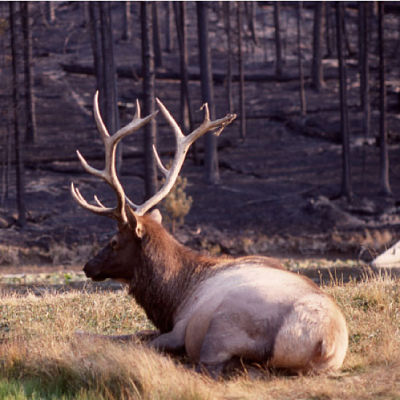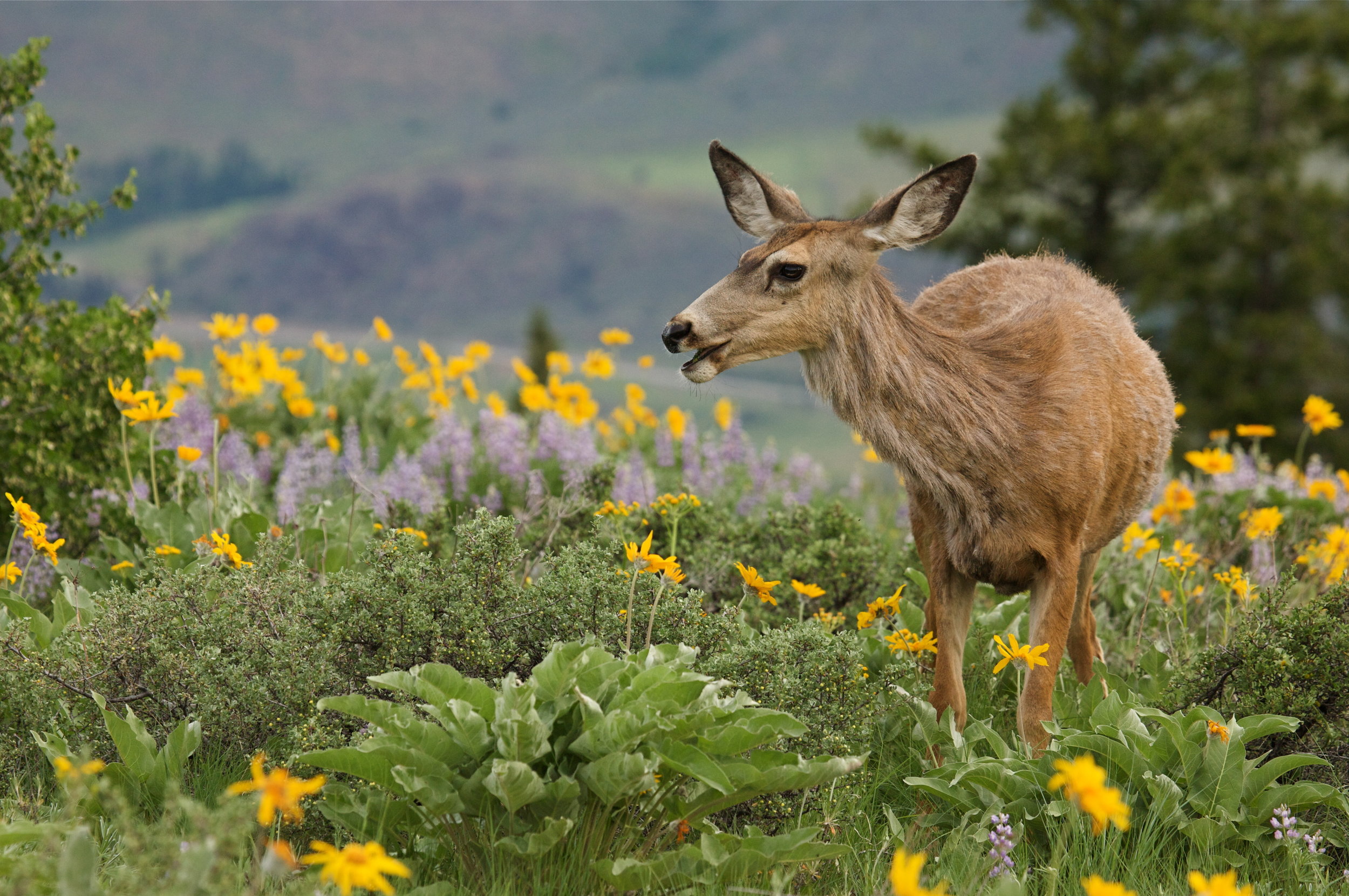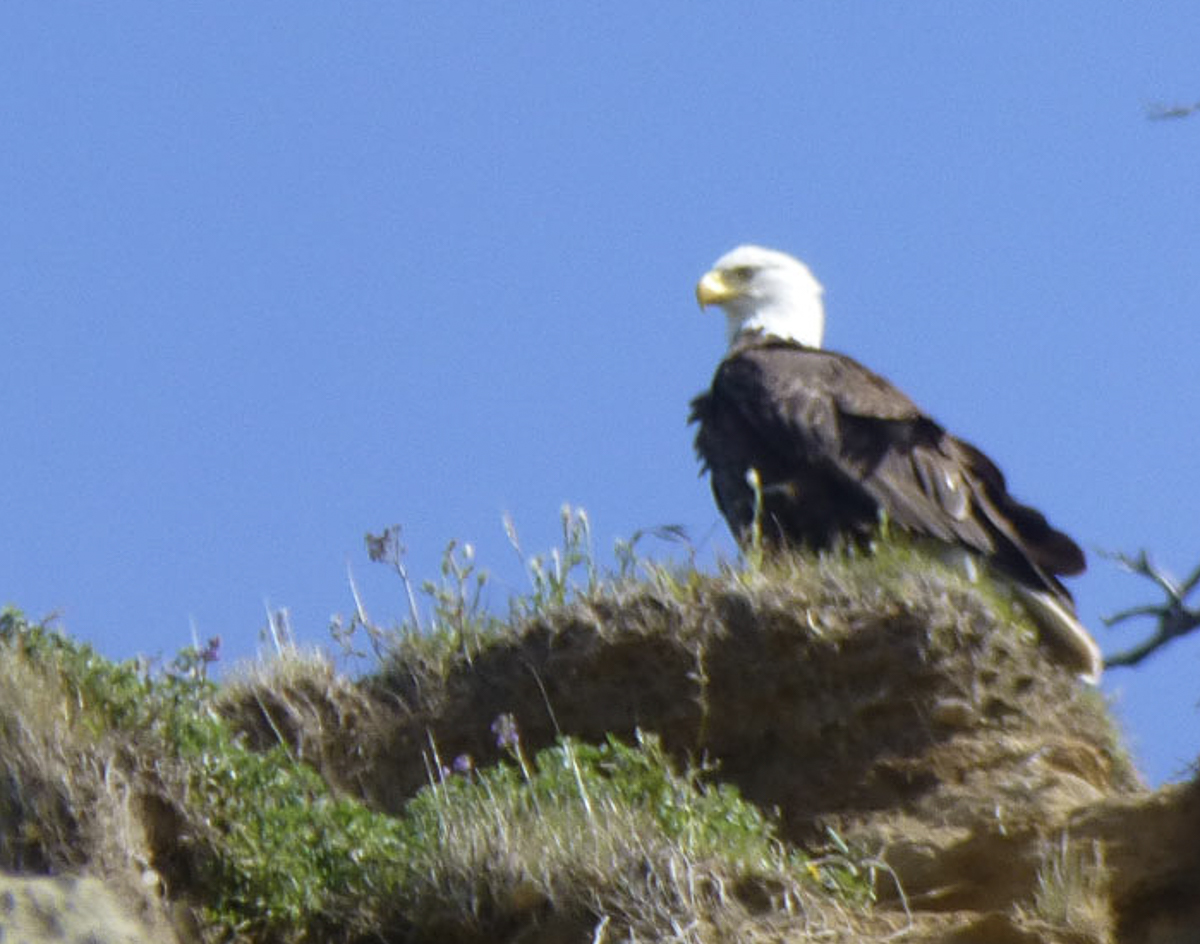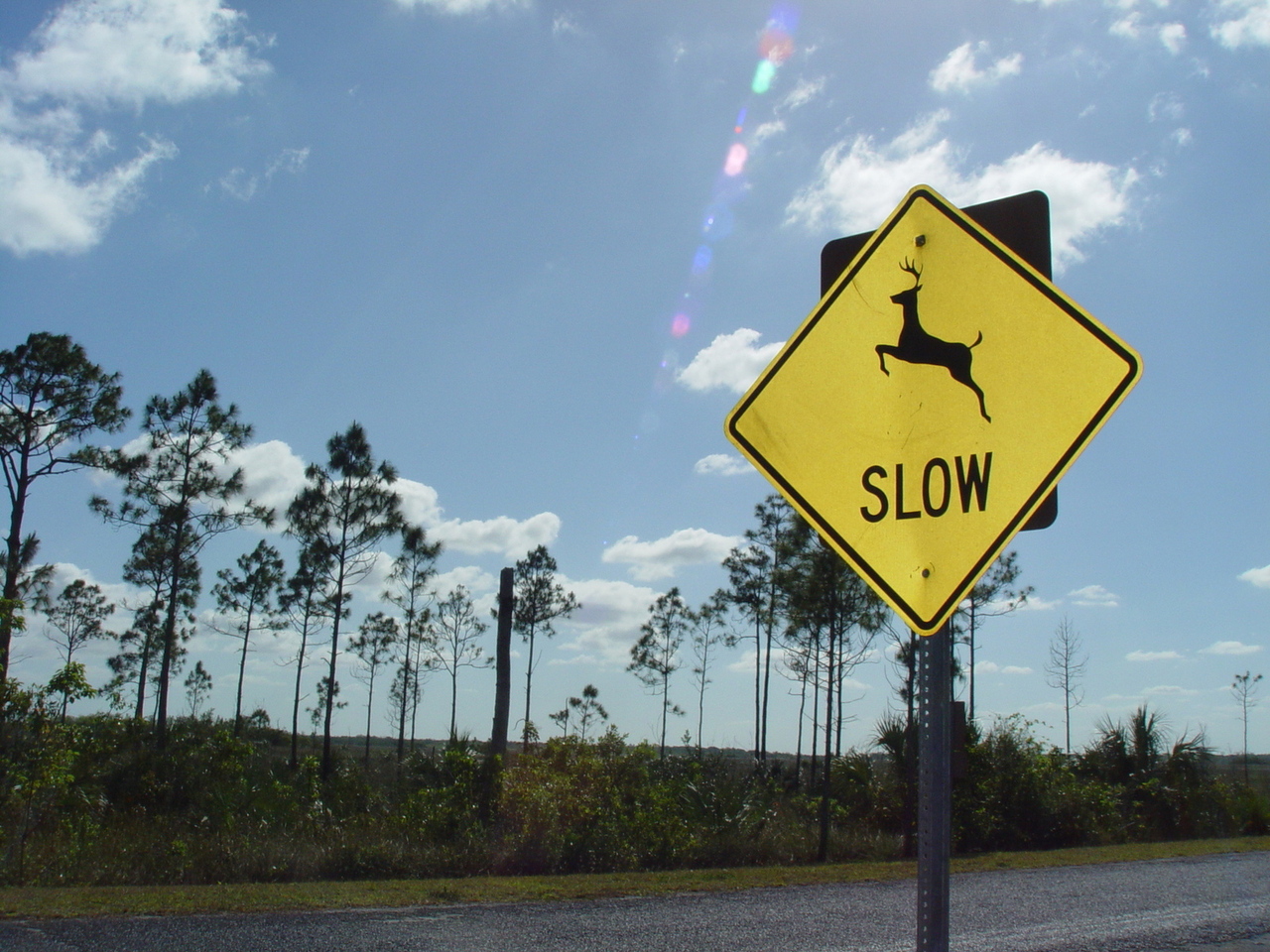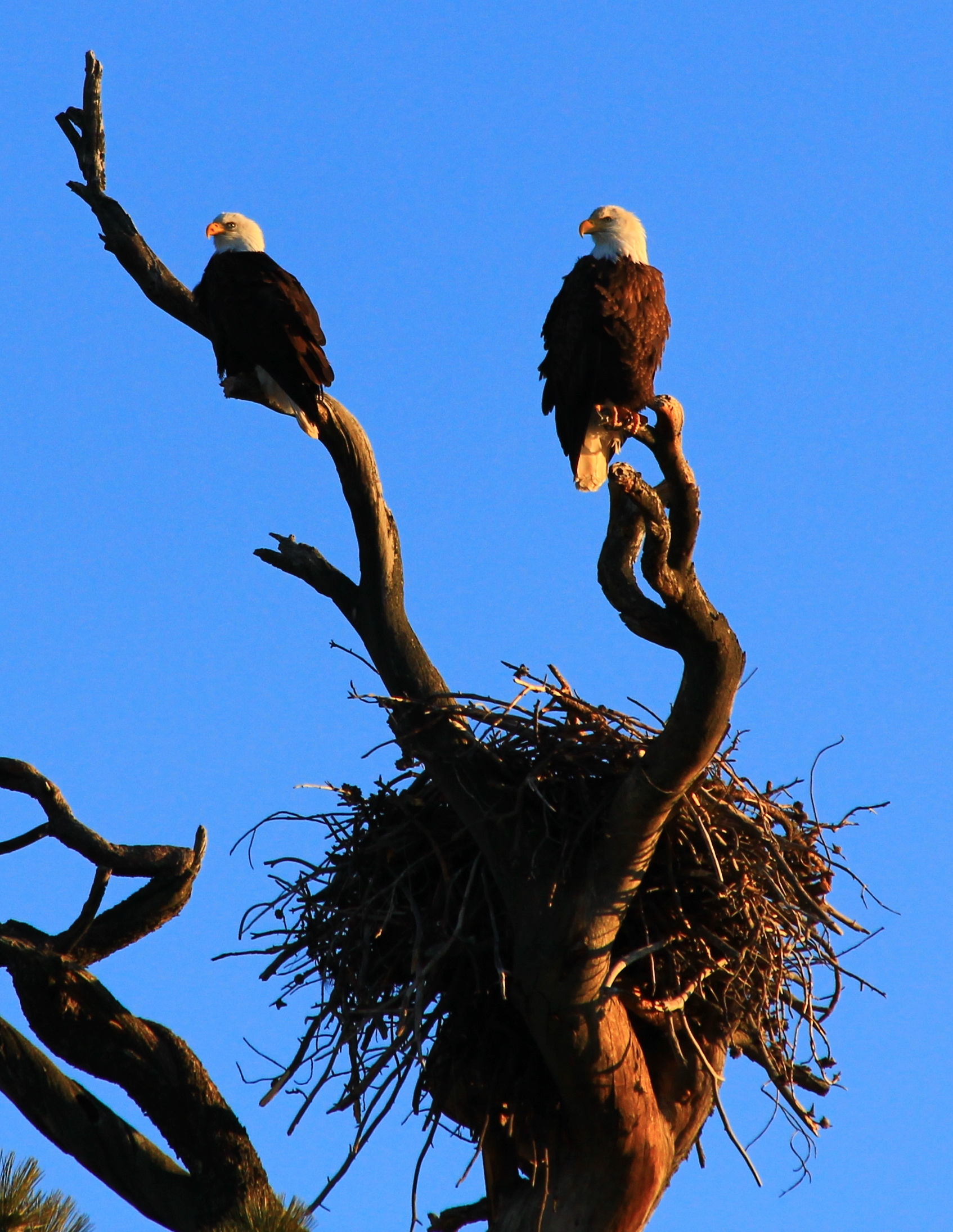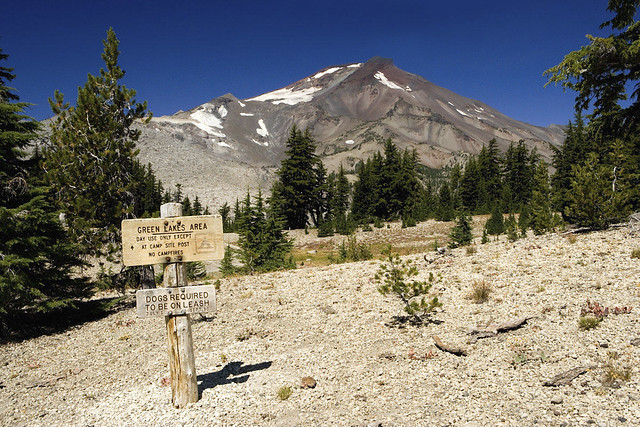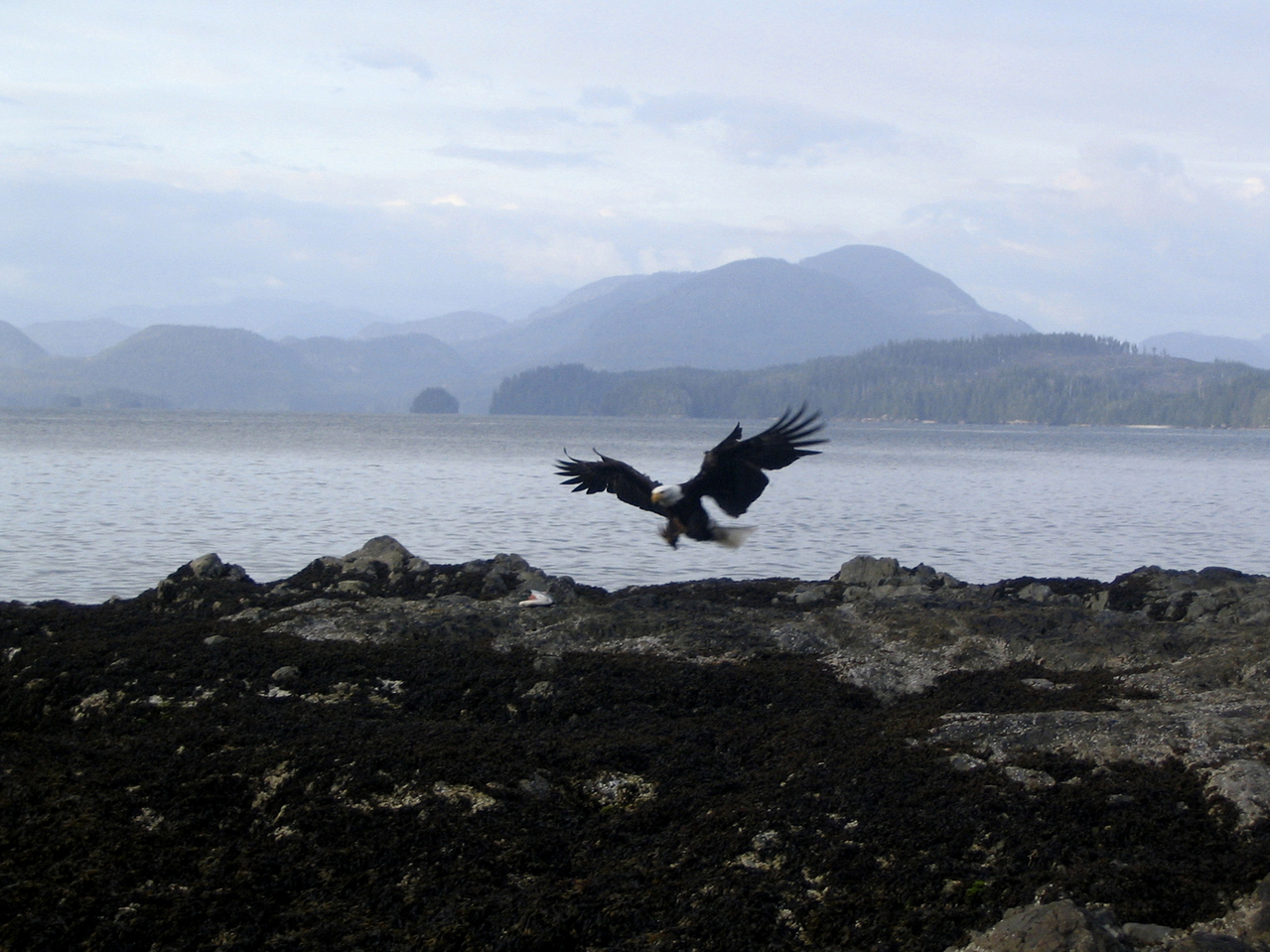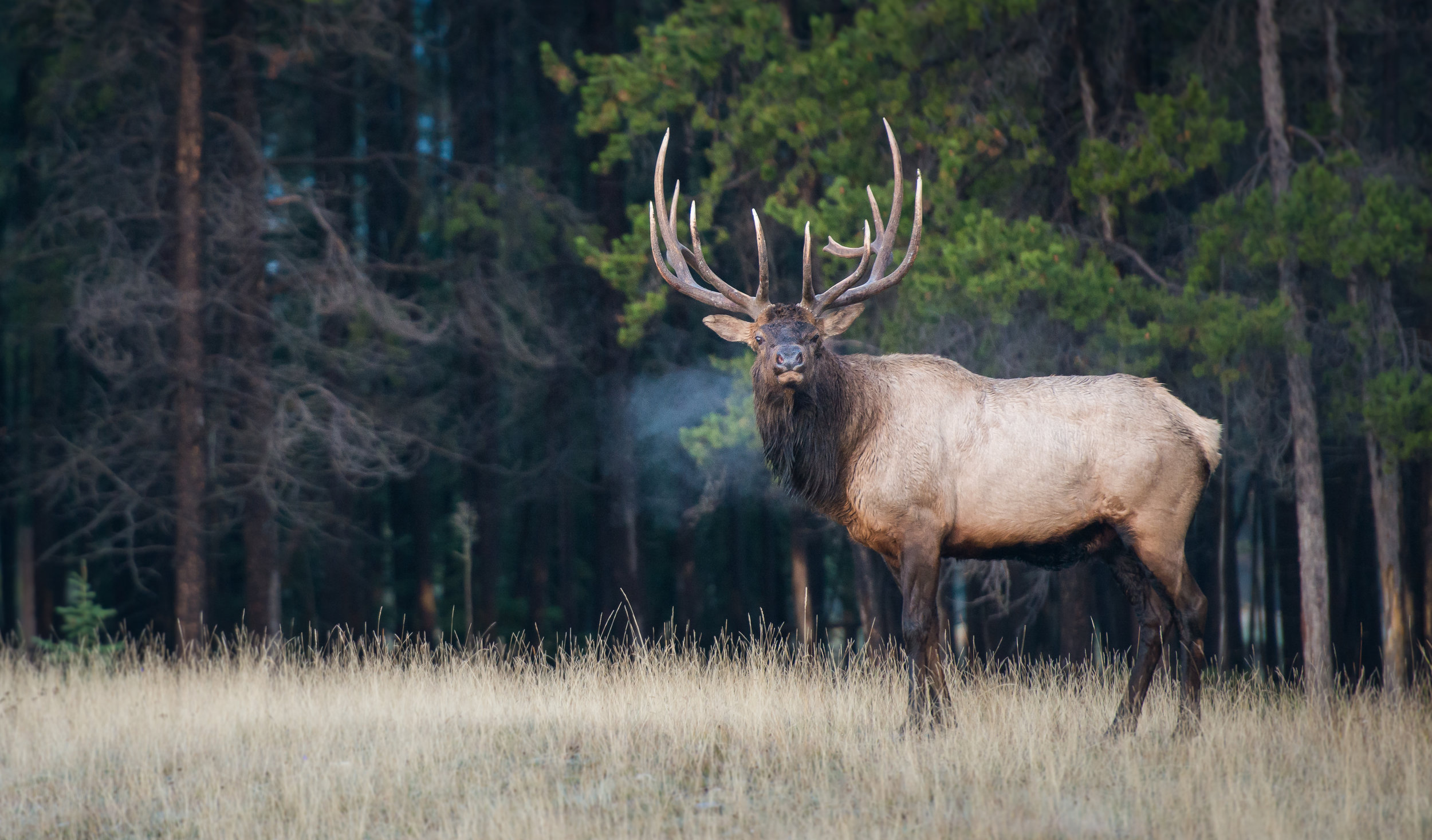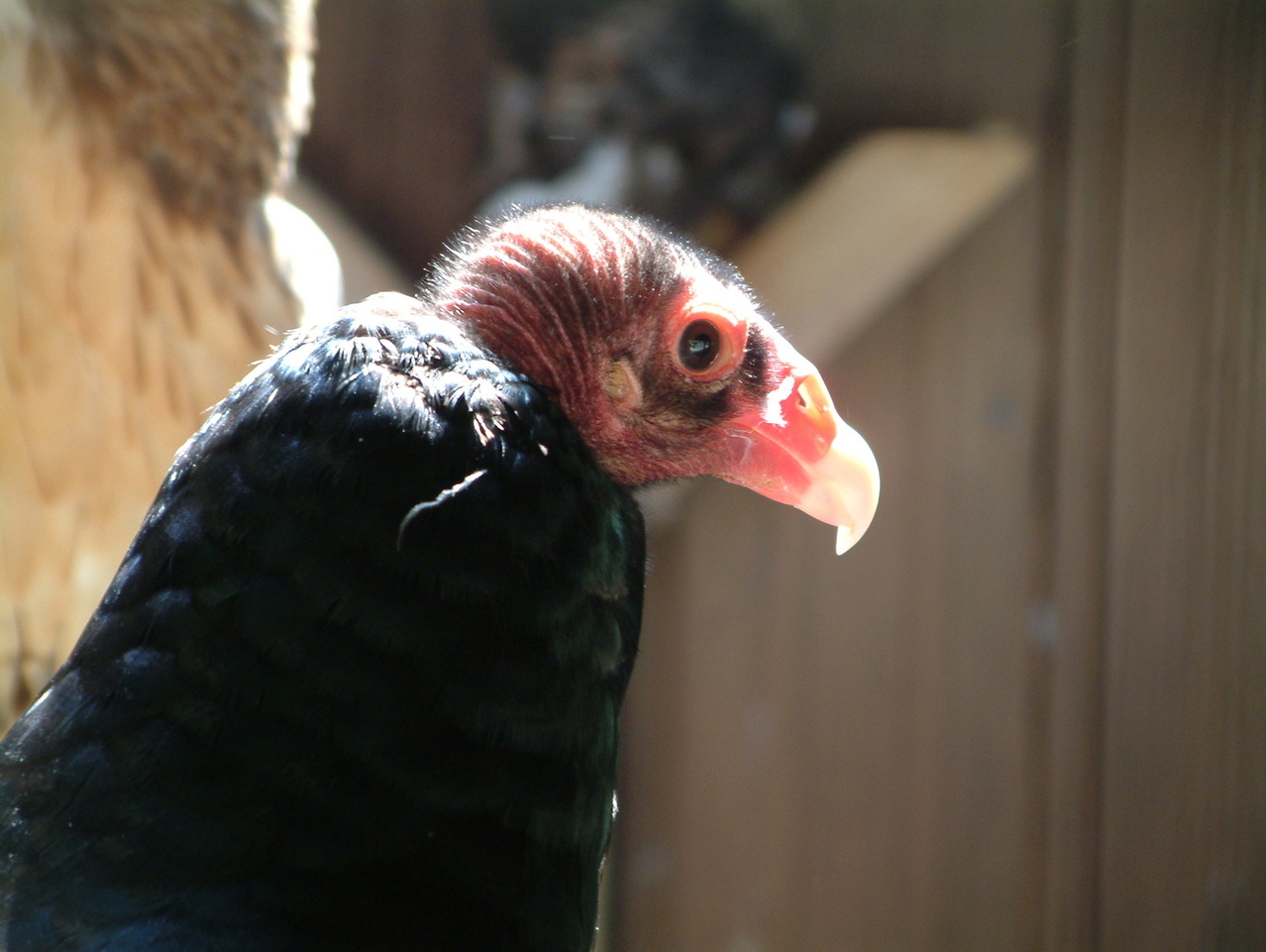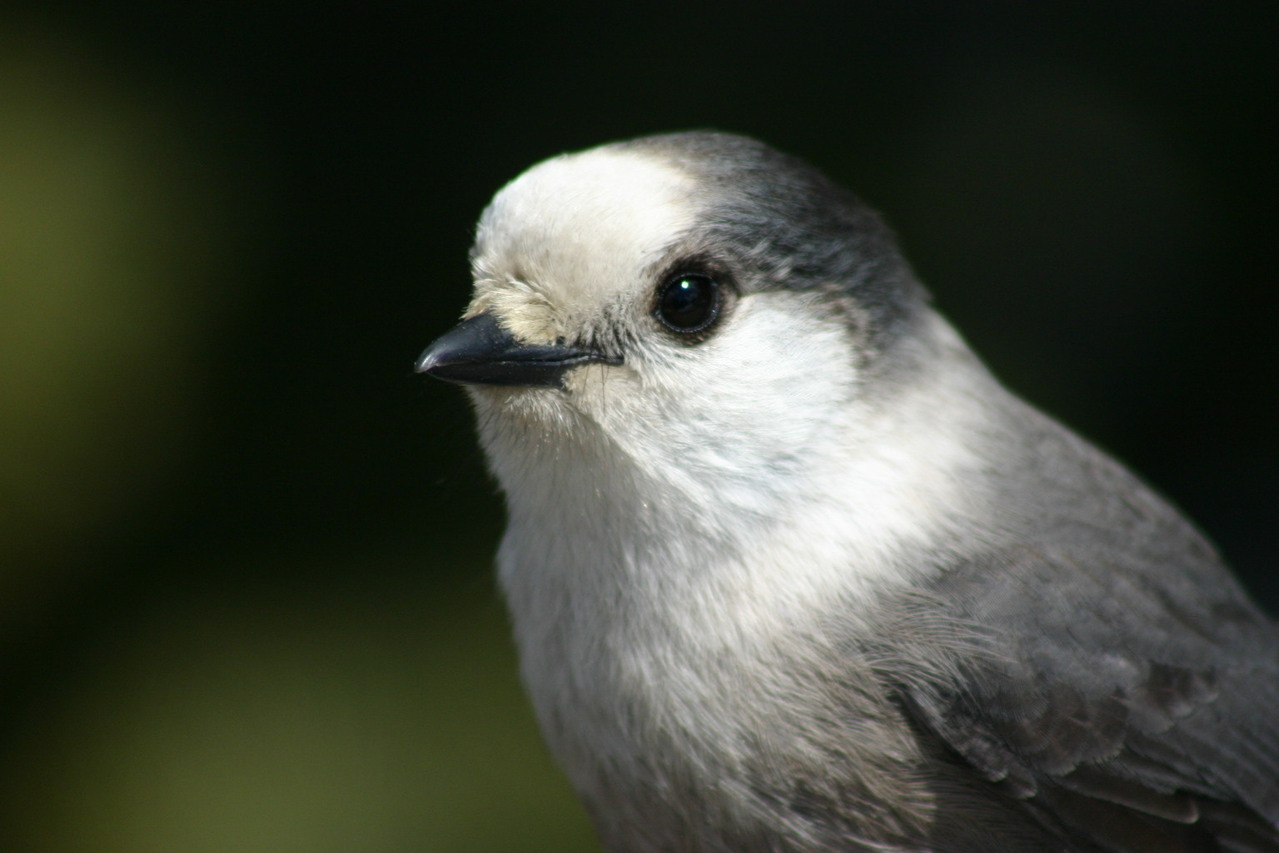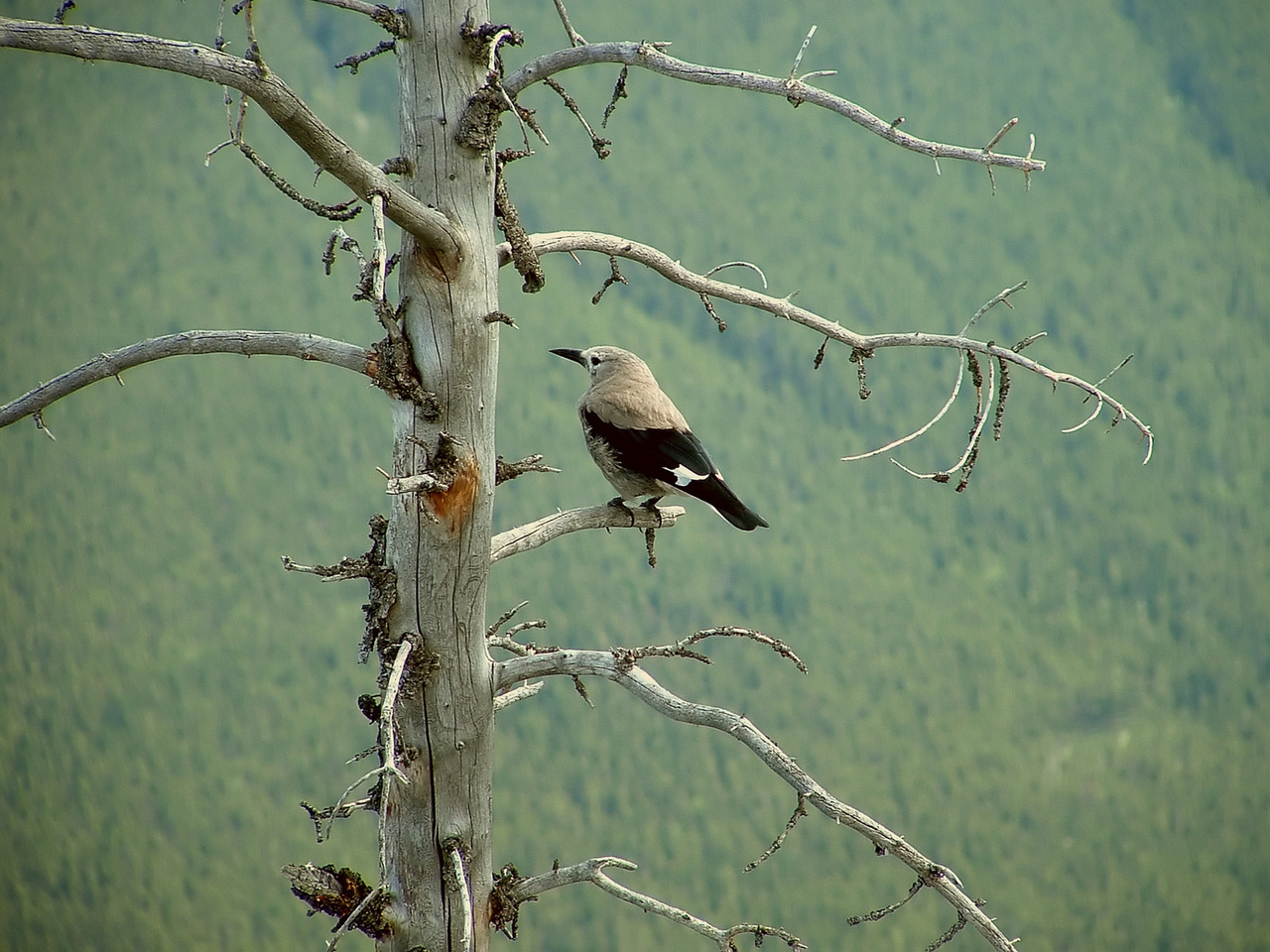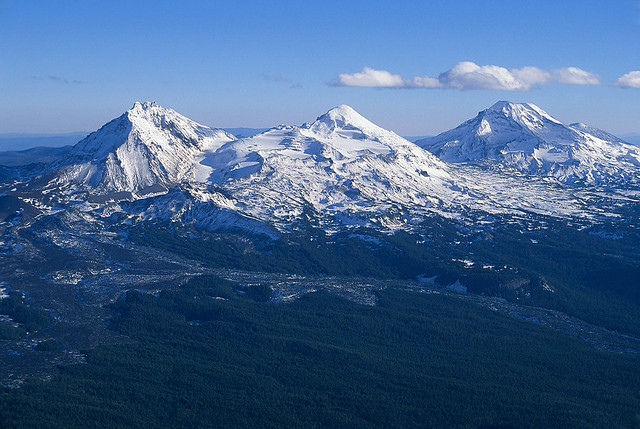
Why does the Three Sisters Wilderness have a capital “W”?
TheThree Sisters Wilderness was set aside by Congress to be a designated Wilderness because of its unique and outstanding characteristics. Wilderness areas like the Three Sisters are protected so that they retain their natural state and are largely untrammeled by man, providing essential habitat for wildlife and preserving their wild characteristics for the enjoyment of future generations. The Deschutes National Forest has five Wilderness areas: the Three Sisters Wilderness, the Mt. Jefferson Wilderness, the Mt. Washington Wilderness, the Diamond Peak Wilderness, and a small piece of the Mt. Thielsen Wilderness.
Do elk sleep standing up?
No, elk sleep lying down just like you do. Their bedding grounds may be located near trails, so please respect their need for quiet. Walk quietly, and let them sleep.
Are bluebirds blue?
Nope, they’re gray! According to the Smithsonian Migratory Bird Center, red and yellow feathers get their color from pigments, called carotenoids, that are in the foods birds eat. But blue is different―no bird species can make blue from pigments. When we see a blue bird, the color is created by the way light waves interact with the feathers and their arrangement of protein molecules, called keratin. Different keratin structures reflect light in subtly different ways to produce different shades of what our eyes perceive as the color blue. A blue feather under ultraviolet light might look uniformly gray to human eyes.
How do you build a safe campfire?
The Five D’s of building a safe campfire are “Down, Dry, Dinky, Dead… and Don’t!”
Down: Build a campfire only out of wood that is already down. Don’t cut firewood from live trees.
Dry: Use only dry wood. Your fire will burn brighter and will produce less smoke if the wood is dry.
Dinky: Build only a small fire. Roaring fires throw off sparks that can ignite the forest around you.
Dead: When you go to sleep or leave camp, make sure your fire is dead out. This means you can use your bare hand to spread the ashes.
Don’t: Only build a campfire in an emergency. If you are cold, wrap up in your sleeping bag or go in your tent. If you are bored, get out your star map! Play word games. Sing!
What’s the skinny on Wilderness trails? When is it OK to hike side-by-side?
Sorry, it’s never OK to hike side-by-side on a Wilderness trail. Wilderness trails are all designed with single-track tread, just wide enough for one person. Wilderness trails are deliberately built for single-file travel. That’s not very romantic, but it does lessen the impact of our footsteps and slows erosion.
How close can I get to a deer?
If you can see a deer, you’re close enough. Deer protect themselves by running away from danger. If you attempt to move closer, the deer will run away from you, using precious energy reserves they’ll need to survive the coming winter. So please, stay back and allow them to calmly go about their lives.
What does Hollywood think of bald eagles?
It’s a scene you’ve probably seen countless times in movies and on TV: an eagle soars overhead and emits a rough, piercing scream. It’s a classic symbol of wilderness and adventure. The only problem? Bald eagles don’t make that sound.
Instead, they emit a sort of high-pitched giggle or weak scream. Their calls are so unimpressive that Hollywood sound editors often dub over bald eagle calls with the piercing, earthy screams of the red-tailed hawk. If you were a fan of The Colbert Report, you might remember the show’s iconic CGI eagle from the opener—it, too, is making that red-tailed hawk cry. Listen for yourself and decide who sounds more impressive.
When do deer and elk obey traffic signs?
Deer and elk obey the “Deer Crossing” signs you see along the highway. That’s because deer and elk follow the same migratory routes year after year as they move between their summer and winter ranges. They typically spend the winter at low elevations, where they can find food and shelter from winter storms. When the weather starts to warm, they migrate to higher elevations where food is plentiful in summer.
Young elk and deer learn these migratory routes by following their mothers and other individuals. Consequently, they use the same migration routes year after year, and over generations. Migration routes can, therefore, be viewed as historical links to elk and deer herds from the past. They continue to follow these same paths to familiar places because they learned that they provide food, shelter, and water.
Are bald eagle nests competition for This Old House?
Indeed, they are. Bald eagles build enormous nests high in the treetops. The male and female build their nest together, and this quality time helps them cement their lifelong bond. Their cozy nurseries consist of a framework of sticks lined with softer stuff such as grass and feathers. If the nest serves them well during the breeding season, they’ll keep using it year after year. And, like all homeowners, they can’t resist the thought of renovating and adding to their abode. Every year, they’ll spruce it up with a whopping foot or two of new material.
On average, bald eagle nests are 2-4 feet deep and 4-5 feet wide. But one pair of eagles near St. Petersburg, Florida, earned the Guinness World Record for largest bird’s nest: 20 feet deep and 9.5 feet wide. The nest weighed over two tons.
When is it OK to take a short cut in the Wilderness?
Sorry, you should never take a shortcut in the Wilderness. Cutting across a switchback leads to loss of vegetation that holds the soil, leading to erosion of the trail below. The whole point of going to a Wilderness is to slow down and smell the wildflowers — to move quietly enough to find solitude. Staying on the trail is the least impactful way you can move thru the Wilderness.
What kind of fish stories do bald eagles tell?
Picture a majestic bald eagle swooping low over a lake and catching a fish in its powerful claws. Yes, bald eagles eat a lot of fish—but they don’t always catch them themselves. They’ve perfected the art of stealing fish from other birds such as ospreys, chasing them down until they drop their prey. Bald eagles also snack on gulls, ducks, rabbits, crabs, amphibians, and more. They’ll scavenge in dumpsters, feed on waste from fish processing plants, and even gorge on carrion (dead, decaying animals).
Do deer and elk eat the same foods?
Deer browse on nutritious shrubs that are high in energy and easy to digest. Elk eat shrubs, too, but they are adapted to eating grasses as well. And because elk are taller, they can browse on tall shrubs that may be out of reach for deer. Studies have also shown that although smaller herbivores like deer require less food, their specialized diet requires that they spend more time selecting the food they need, compared to elk that can eat large mouthfuls of grass in a short period of time.
How fast can golden eagles dive?
In a full dive, golden eagles can reach speeds of 200 miles per hour, making it the second fastest animal in the world, just behind the peregrine falcon. Golden eagles are graceful and incredibly quick birds, considered by many experts to be the most superlative fliers among all the birds of prey. Although not as well-known as their cousin, the bald eagle, this animal is truly an amazing and beautiful creature, and it is the most widely distributed type of eagle in the world.
Golden Eagles have brown eyes that can sight a rabbit two miles away, a yellow beak, and dark brown feathers with golden-brown plumage on the back of their necks. They can grow to a length of 3 feet with a wingspan of about six feet. Their powerful wings allow them to pick up prey animals weighing up to 5 pounds. Their razor-sharp talons can grow to 3 inches long.
Are osprey double crossers? Does X mark the spot?
Osprey are among the best fishermen in the world. One reason why is that they have X-shaped toes. Two toes are positioned forward and two backward to facilitate holding of the prey. Their talons are equipped with backward-oriented scales that act like barbs to hold slippery fish firmly. And after catching a fish, an osprey flies away holding the fish parallel to its body to decrease air resistance. Ospreys fly south during the winter, traveling 160 to 170 miles per day during the migratory season. Their natural enemies include raccoons, which steal their eggs, and Nile crocodiles, which hunt adult birds when they land on the surface of the water to catch fish.
Why do turkey vultures defecate on their feet?
During hot weather, turkey vultures will defecate on their feet to cool them off. Since a vulture’s digestive juices kill bacteria (which is why vultures don’t get sick from eating rotten meat), defecating on their legs might also work as an antiseptic wash. Bonus Fun Fact: vultures eat rotting flesh, but their poop is sterile. They’re Mother Nature’s original cleanup crew.
Why are bald eagles called The Come Back Kids?
Before European settlers arrived, bald eagles were abundant across the U.S. But with settlement came habitat destruction, and the settlers viewed the eagles as competition for game and a threat to livestock. Over time, so many eagles were killed that in 1940 Congress passed an act to protect the birds.
Unfortunately, another threat rose up at about that time. Starting after World War II, farmers and public health officials used an insecticide called DDT. The chemical worked well to eradicate mosquitos and agricultural pests, but as it traveled up the food chain, it began to harm birds of prey. DDT made eagle eggshells too thin and caused the eggs to break and eaglets die. A 1963 survey found just 471 bald eagle pairs in the lower 48 states.
DDT was banned in the early 1970s, and conservationists began to breed bald eagles in captivity and reintroduce them in places across America. Luckily, bald eagles have made a spectacular recovery, and now the lower 48 states boast over 9,700 nesting pairs .
How far can turkey vultures vomit?
Turkey vultures use vomit to defend themselves. If a turkey vulture is disturbed or harassed, it will throw up on the animal that is bothering it, sending vomit sailing up to 10 feet. Even vulture babies will vomit on other animals. This behavior serves turkey vultures well: vulture vomit is an effective predator repellent.
One reason the vomit factor is important is that, unlike bald eagles, TVs spend no time building nests. They just plop their eggs on the ground, with any little depression being considered a convenient nest. Because their eggs and young are thus very vulnerable, they use the vomit factor as a defense against predators. Imagine the surprise of some prey animal/bird when, just as they are about to nab a nice juvenile turkey vulture for lunch, it turns on them and sprays them with vomit!!! Apparently, even snakes don’t like vomit and stay away.
What color are Sierra Nevada red foxes?
Sierra Nevada red foxes, which are quite rare, come in three color patterns: silver, red, and half-n-half. What they all have in common is a white tail, a white chest patch, and long black leggings and booties.
What’s really cool about our local red fox is that until a few years ago, they were thought to be extinct. Then one was seen begging for French fries in the Mt Bachelor parking lot. It was tagged and monitored and led to scientists discovering, capturing and collaring several more – all within 8 miles of Mt Bachelor. Hikers now report sightings away from the ski resort, and cameras are being deployed to monitor them. Usually, these shy creatures hang out in the high forests (above 4,500 feet), but they have been seen as low as 3,000 feet near Tumalo Reservoir.
Who’s stealing your lunch?
It’s a camp robber! Those birds that swoop down and try to make off with part of your sandwich are officially known as gray jays. They’re very bold and will beg from campers, follow hikers, and go inside cabins to steal food. Gray jays forage from perches and fly from tree to tree, scanning for food.
Camp robbers cache food during the summer and fall, using sticky saliva to paste it beneath tree bark and in other hidden spots above the height of the eventual snow line. The jays eat this stored food during the winter when other food sources are scarce, enabling them to survive the winter.
Strangely enough, gray jays in flight often carry food with their feet. Other songbirds carry food in their beaks.
Who’s that calling out “me, me, me”?
It’s a pika, also known as a rock rabbit. Pikas live in colonies on rocky slopes in the forest and are very territorial. They make their signature “me, me, me” sound to tell other pikas where the boundaries are between their dens. Though they don’t look like it, pikas are related to rabbits and hares. Their short ears, tiny size, and dense coats make them look more like fuzzy balls than bunnies. The pika has one of the longest tails of all lagomorphs, but it’s hidden in the thick fur, so it looks like it doesn’t have a tail at all.
The pika spends a great deal of time gathering flowers and grasses for winter. Pika don’t hibernate. Instead, they spend the warm months gathering vegetation to sustain them through the long, harsh winters. They spread their collected vegetation on the rocks to cure in the sun, then stack it into hay piles and store it under the rocks. One study discovered their ‘haystacks’ of gathered goodies can weigh up to 61 pounds! These stashes may easily cover an area of 100 square meters and can reach up to two feet high. A typical pika hay pile would fill a bathtub, and easily contains 30 different types of plants. Biologists have learned that during just a 10-week time period, one pika will make 14,000 foraging trips, as many as 25 per hour, to secure its food stash.
What’s so special about Clark’s nutcrackers?
Clark’s nutcracker is a gray bird with black and white wings and central tail feathers. They have special pouches under their tongues in which they carry pine seeds long distances to cache them. Depending upon the species of pine seed, their pouch will hold from 28 and 90 seeds.
Named for William Clark of the 1805 Lewis and Clark Expedition fame, the nutcracker was initially thought to be a woodpecker because of its habit of pounding on pine cones and chiseling tree bark. But more careful observation revealed that it was hiding its food to eat in the winter.
Unusual among members of the crow family, males of this species help the females incubate the eggs. In fact, the males have brood pouches just like the females. Nestlings are fed pine seeds from the parents’ caches. This allows the adults to breed as early as January or February despite the harsh winter weather in their range.
If you drop something on a hike, how long will it take to decompose?
It takes much longer than you might think for litter to decompose. Here are a few examples.
…an orange peel? 6 months
…a wet wipe? 100 years, because of the plastic it contains
…a plastic water bottle? 450 years
…a snack bar wrapper? Never! Foil doesn’t biodegrade.
… Toilet Paper? If buried 6” in the soil, 5 weeks
If exposed, 7-10 weeks
If under a rock, many years
If above 6000 feet, same… but add a year!
Please, pack out your trash!

